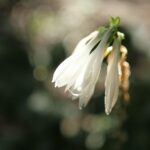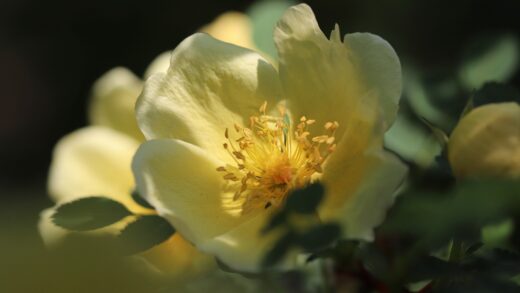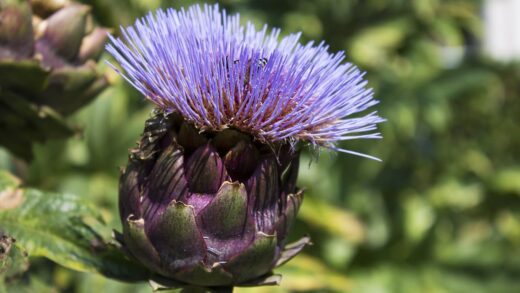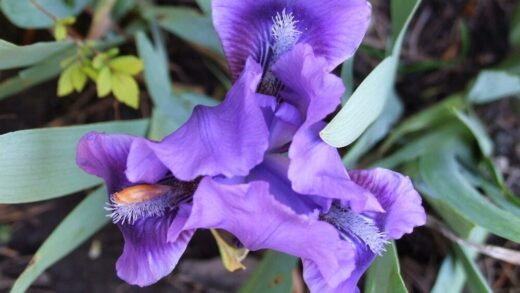Biting stonecrop, also known as goldmoss stonecrop, is an exceptionally resilient and low-maintenance perennial succulent that thrives in conditions where many other plants would falter. Its appeal lies in its dense, mat-forming habit, with bright green, fleshy leaves that create a vibrant carpet of foliage throughout the year. During its blooming season in late spring and early summer, it produces a stunning display of star-shaped, bright yellow flowers that attract a variety of pollinators, including bees and butterflies. This plant is perfectly suited for rock gardens, green roofs, crevice plantings, and as a ground cover in sunny, dry areas, requiring minimal intervention once established to provide long-lasting texture and color.
This succulent’s adaptability makes it a favorite among gardeners looking for drought-tolerant solutions and vibrant ground cover. Its shallow root system allows it to grow in thin, poor soils, making it an excellent choice for challenging garden spots. Because it spreads readily, it can quickly fill in gaps between paving stones or along pathways, suppressing weeds as it establishes. Understanding its basic needs for sunlight, water, and soil is the key to cultivating a healthy, sprawling mat of this charming plant, ensuring it performs at its best without becoming invasive or sparse.
The care routine for biting stonecrop is refreshingly simple, focusing more on providing the right initial conditions than on continuous upkeep. The primary requirements are excellent drainage and ample sunlight, which mimic its native habitat of rocky outcrops and sandy soils. Over-attentive care, such as excessive watering or fertilization, can actually be detrimental to its health, leading to root rot and weak, leggy growth. Therefore, a hands-off approach is often the most successful strategy for maintaining its compact form and prolific flowering.
Throughout this guide, we will explore the essential aspects of caring for this remarkable plant, from its ideal environmental conditions to routine maintenance practices. We will cover how to manage its growth, address potential issues, and ensure it remains a beautiful and functional element in the garden design. By following these professional recommendations, anyone can successfully cultivate biting stonecrop and enjoy its unique aesthetic and ecological benefits for years to come.
Soil and location requirements
The foundation of successful biting stonecrop cultivation lies in selecting the appropriate location and providing the right soil composition. This plant demands full sun exposure to thrive, meaning it needs at least six to eight hours of direct sunlight each day. A south-facing or west-facing location is typically ideal, as these spots receive the most intense and prolonged light. Insufficient sunlight will cause the plant to become etiolated, or “leggy,” as it stretches in search of light, resulting in sparse growth, weaker stems, and significantly reduced flowering, compromising its desirable dense, mat-like appearance.
Proper soil drainage is arguably the most critical factor for the health of biting stonecrop, as it is highly susceptible to root rot in waterlogged conditions. The ideal soil is sandy, gritty, or gravelly, with low to moderate fertility. Heavy clay soils that retain moisture must be amended to improve their structure and drainage before planting. Incorporating materials such as coarse sand, perlite, or fine gravel will create the air pockets necessary for the roots to breathe and prevent excess water from stagnating around the root zone.
When preparing a planting site, consider the natural environment of this succulent. It often grows in the shallow soil of rock crevices, on walls, or in sandy coastal areas. Replicating these conditions in a garden setting will guarantee success. For rock gardens, simply tucking small plant divisions into pockets of soil between stones is sufficient. For larger ground cover areas, ensuring the entire bed has been amended for sharp drainage is crucial for long-term health and the prevention of fungal diseases.
Container cultivation is also an excellent option, especially for patios, balconies, or areas with poor native soil. When planting in pots, use a specialized cactus or succulent potting mix, which is formulated to provide the fast drainage that these plants require. Ensure the container has ample drainage holes at the bottom to allow excess water to escape freely. Terracotta or unglazed ceramic pots are particularly beneficial as their porous nature helps the soil to dry out more evenly between waterings.
Watering and moisture management
Understanding the water requirements of biting stonecrop is straightforward: it thrives on neglect and is exceptionally drought-tolerant once established. Its succulent leaves are adapted to store water, allowing it to withstand extended periods of dryness. The most common mistake in caring for this plant is overwatering, which quickly leads to crown and root rot, a condition from which it rarely recovers. Therefore, the guiding principle for irrigation should always be to water sparingly and allow the soil to dry out completely between sessions.
For newly planted stonecrop, a slightly more attentive watering schedule is necessary to help it establish a robust root system. During the first few weeks after planting, water the area lightly whenever the top inch or two of soil feels dry to the touch. This encourages the roots to grow outwards in search of moisture. However, even during this establishment phase, it is vital to avoid saturating the soil; a light sprinkling is often sufficient to meet its needs without creating anaerobic conditions.
Once the plants are well-established, which typically takes one growing season, their need for supplemental watering diminishes dramatically. In most temperate climates, natural rainfall is sufficient to sustain them throughout the year. You may only need to provide water during prolonged and severe droughts, especially during the hottest summer months. When you do water, it is best to do so deeply but infrequently, allowing the moisture to penetrate the root zone and then letting the soil dry out thoroughly before considering watering again.
The visual cues of the plant itself can be an excellent indicator of its water needs. If the fleshy leaves begin to look slightly wrinkled or feel less turgid, it may be a sign that the plant is using up its water reserves and could benefit from a drink. Conversely, if the foliage appears yellow, mushy, or translucent, and the stems are weak, you are almost certainly overwatering. Adjusting your watering habits based on these observations, as well as prevailing weather conditions, is the most effective way to maintain optimal plant health.
Light and temperature considerations
Biting stonecrop is a true sun-worshipper, and its growth, color, and flowering are directly influenced by the amount of light it receives. To achieve the characteristic dense, low-growing mat and vibrant golden-yellow blooms, a location that provides at least six hours of direct, unfiltered sunlight per day is essential. In full sun, the foliage often takes on a brighter, more chartreuse hue, and in some cases, the tips of the leaves may develop a reddish tinge, adding to its ornamental appeal. This stress-induced coloration is a natural and desirable trait.
While it is most vigorous in full sun, this versatile succulent can tolerate partial shade, although its appearance may change. In shadier conditions, with only three to four hours of direct sun, the plant will still grow but is likely to become taller and less compact. The stems will elongate as they reach for more light, creating a leggier and more open habit. Furthermore, flowering will be significantly sparser or may not occur at all, and the foliage will typically remain a deeper shade of green without the vibrant highlights seen in full sun.
In terms of temperature, biting stonecrop is remarkably hardy and adaptable to a wide range of climates. It is typically winter-hardy in USDA zones 3 through 9, capable of withstanding significant cold and frost once it is well-established in the ground. During winter, the foliage may die back or take on a bronze or reddish color, which is a normal response to cold stress and not a sign of disease. The plant enters a dormant state and will resume vigorous growth as the temperatures rise in spring.
This plant also exhibits excellent heat tolerance, making it a superb choice for hot, dry areas of the garden, such as south-facing slopes, rockeries, or alongside heat-retaining pavement. Its succulent nature allows it to conserve water efficiently during periods of high heat and low rainfall. However, in extremely hot desert climates, providing some light afternoon shade can be beneficial to prevent the foliage from scorching, although this is generally not a concern in more temperate regions.
Pruning and maintenance throughout the year
One of the most appealing aspects of biting stonecrop is its minimal need for pruning and ongoing maintenance. This plant naturally maintains a low, spreading habit without regular intervention. However, occasional trimming can be beneficial for aesthetic purposes, to control its spread, or to rejuvenate older, less vigorous patches. The primary maintenance tasks involve cleaning up any winter damage and managing its expansion if it begins to encroach on other plants or desired open spaces in the garden.
In early spring, as new growth begins to emerge, it is a good time to assess the plant for any winter dieback. You can gently rake or trim away any dead or desiccated foliage from the previous year to improve air circulation and make way for fresh, healthy growth. This spring cleanup helps to maintain the tidy appearance of the plant mat and can encourage more uniform growth throughout the season. This is also the perfect opportunity to press any stems that have been heaved up by frost back into contact with the soil.
After the plant has finished its main flowering period in early summer, you can perform a light shearing to remove the spent flower heads. This process, known as deadheading, is not strictly necessary for the plant’s health but can significantly improve its appearance, preventing it from looking untidy. Shearing the plant back by about half its height at this time can also promote a denser, more compact growth habit and may even encourage a sporadic rebloom later in the season under ideal conditions.
Because biting stonecrop can spread quite vigorously in optimal conditions, you may need to control its boundaries from time to time. This is easily accomplished by simply trimming the edges of the plant mat with garden shears or by pulling up runners that have extended too far. These removed pieces can be easily replanted elsewhere if desired, as they will readily root where they make contact with soil. This periodic edging, perhaps once or twice a year, is usually all that is needed to keep the plant within its intended area.
Common challenges and solutions in care
Despite its toughness, biting stonecrop can encounter a few issues, most of which are directly related to improper cultural practices, particularly excessive moisture. The most significant threat to this succulent is root and crown rot, caused by pathogenic fungi that thrive in overly wet, poorly drained soil. Symptoms include mushy, yellowing, or browning foliage at the base of the plant, weak stems, and a general failure to thrive. Prevention is the best solution: ensure the plant is in fast-draining soil and avoid overwatering at all costs.
If you suspect root rot has taken hold, you must act quickly to save the plant. Carefully dig up the affected section and inspect the roots. Healthy roots should be firm and white, while rotted roots will be dark, soft, and mushy. Trim away all rotted portions with a sterile cutting tool, and if any healthy sections remain, they can be replanted in a new location with improved drainage or in a container with fresh, dry succulent mix. Discard the diseased soil and plant material to prevent the fungus from spreading.
While generally resistant to pests, biting stonecrop can occasionally be bothered by common garden insects such as aphids, mealybugs, or scale. These pests are more likely to attack plants that are stressed, for instance, by incorrect growing conditions. Aphids can be dislodged with a strong spray of water from a hose. For more persistent infestations of mealybugs or scale, dabbing the insects with a cotton swab dipped in isopropyl alcohol or applying an insecticidal soap can be effective treatments.
In some garden settings, slugs and snails may be drawn to the succulent foliage, leaving behind their characteristic ragged holes and slime trails. These pests are most active at night and in damp conditions. Control methods include setting out beer traps, using slug and snail baits, or creating a barrier of crushed eggshells or diatomaceous earth around the plant patch, as these creatures dislike crawling over sharp, abrasive surfaces. Encouraging natural predators like birds and frogs in the garden can also help to keep their populations in check.


















